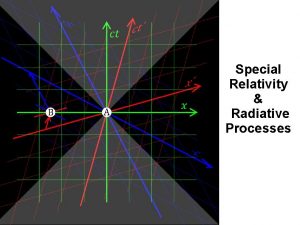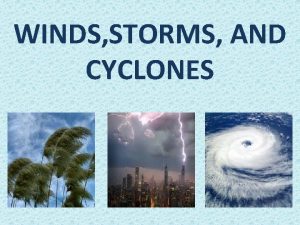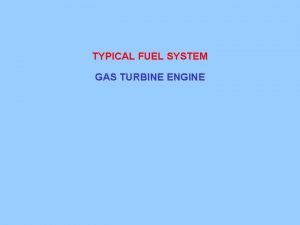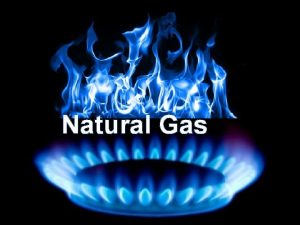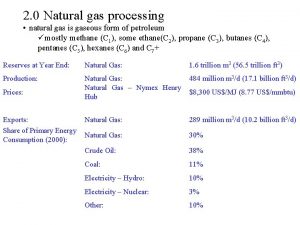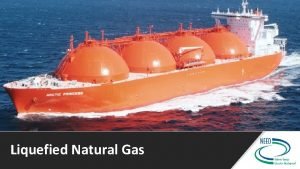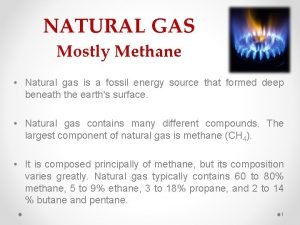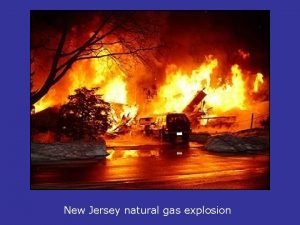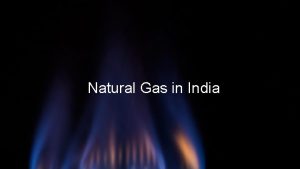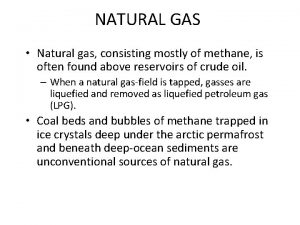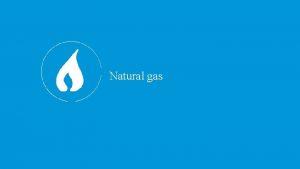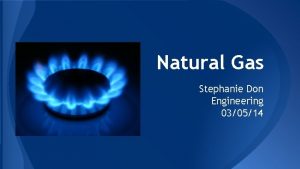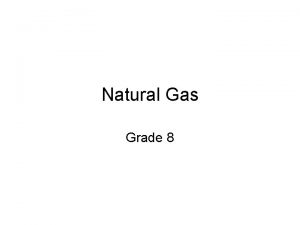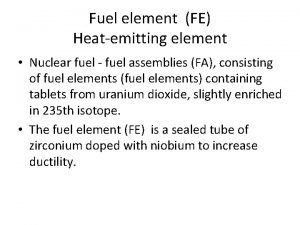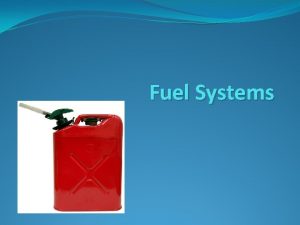Natural Gas Fuel indeed or Fuel in need



















- Slides: 19

Natural Gas: Fuel indeed or Fuel in need? by Mahdjouba BELAIFA Head of Gas Market Analysis Department GECF Secretariat 8 th Bosphorus Summit, Istanbul, Turkey Gas - The Future or a Transition Fuel Only 29 November 2017 29 th November , 2017

22 Contents q GECF Views on Natural Gas Markets q Key Challenges for Natural Gas q Credentials of Natural Gas vis-a-vis SDGs q Position of GECF towards Natural Gas Role Gas - The Future or a Transition Fuel Only 29 November 2017

33 Natural Gas Consumption will continue to grow Will it grow enough to absorb the growing supply? Natural Gas Consumption by Region (Bcm) 4000 3500 3000 2500 2000 1500 1000 500 0 2016: Natural Gas Consumption by Region (%) Asia Pacific 20% North America 27% 20 16 20 17 * 20 18 * 20 15 20 14 20 13 20 12 20 11 20 10 20 09 20 08 20 07 20 06 Africa 4% North America S. & Cent. America Europe & Eurasia Middle East Africa Asia Pacific Middle East 14% S. & Cent. America 5% Europe & Eurasia 29% Source: BP Statistical Review, Cedigaz (*) GECF assessment q World natural gas consumption growth: ~1. 8% in 2016 to reach 3. 54 Tcm ~63 Bcm more compared to 2015. driven by Europe (U. K. , France, Germany, Italy and The Netherlands), Asia (China and India) and the Middle East region. q Expected growth in 2017: ~ 2% primarily driven by Europe and Asia. q Expected growth in 2018: ~ between 2. 1% and 2. 2%. q Why? : Weather conditions, economic expansion mainly in Asia (China, India), competitive prices and environmental concerns Gas - The Future or a Transition Fuel Only 29 November 2017

44 Natural Gas Production: Conventional & Unconventional Growth driven by unconventional Gas Bcm GECF and Non-GECF Natural Gas Production 4, 000 3, 500 3, 000 2, 500 2, 000 1, 500 1, 000 500 0 45. 9% 45. 3% 45. 5% 44. 2% 43. 6% 2010 2011 2012 GECF (Members + Observers) 2013 2014 NON-GECF 2015 43. 7% 46. 5% 46. 0% 45. 5% 45. 0% 44. 5% 44. 0% 43. 5% 43. 0% 42. 5% 42. 0% 2016 GECF Share (%) q Global natural gas production continue to grow y-o-y reaching ~ 3. 6 Tcm in 2016: Unconventional gas production (shale oil and gas output in the US as oil prices pick up). q China continue to ramp up unconventional gas production to ~7. 9 Bcm in 2016 missing the target. Petro. China and Sinopec planned to rise output from the Sichuan basin in 2017. q Conventional gas remains the dominant source of gas production (~2. 8 Tcm in 2016) majorly from GECF Member countries. q More gas production expected in the future (power generation, new LNG projects and environmental concerns) with global gas production expected to top 3. 7 Tcm towards 2018/2019. Gas - The Future or a Transition Fuel Only 29 November 2017 Data: Rystad Energy Dec 2016 & BP June 2017, Reuters. , China’s Ministry of Land Resources 4

Trend in Global LNG Trade 55 Significant Growth Triggered by New LNG Production LNG Trade 2016: 263 mtpa LNG Trade by Region 2012 -2016 300 1. 2% Million tons 250 2. 4% 1. 5% 6% 200 150 100 50 200 180 160 140 120 100 80 60 40 20 - Asia Europe Asia 2012 Europe 2013 Latin America 2014 2015 2016 Middle East U. S. /Canada GECF Latin America Middle East U. S. / Canada Non-GECF Source: ICIS LNG EDGE Global LNG Trade grew by 6% to reach around 263 million tons in 2016. Asia accounted for 72% of the total LNG trade followed by Europe with 15%, Middle East with 6% and Americas 6% ▲ UP: Asia 189 MT (7%) & Middle East 17 (71%) ▲▼ EQUAL: Europe 41 MT or 0. 6% increase ▼DOWN: Latin America 14 MT (-22. 1%) & U. S. /Canada 2 MT (-15. 7%) Gas - The Future or a Transition Fuel Only 29 November 2017 GECF exported ~60% of the Global LNG supplied in 2016 Regional LNG imports supplied by GECF: • Asia – 46% • Europe – 98% • Latin America – 78% • Middle East – 84% • US/Canada – 100%

66 Global LNG Trade in 2017 New Records Global LNG Trade (mtpa) 30 200 180 160 140 120 100 80 60 40 20 0 25 20 15 10 5 171. 80 38. 76 Asia Middle East U. S. / Canada 7* Oc t'1 17 7 p' Se 7 '1 g'1 Au 17 Latin America Ju l n' Ju '1 7 7 ay M 7 r'1 '1 Ap 17 ar M 7 b' '1 Europe Fe 6 Ja n c'1 6 v'1 De No Oc t'1 6 - LNG Trade by Region (mtpa) and variation (%) y-o-y Europe 13. 70 12. 98 1. 48 Middle East Latin America U. S. / Canada Jan-Oct 2016 Jan-Oct 2017 Data Source: ICIS LNG EDGE. GECF calculations. (*) Preliminary Figures Data Source: ICIS LNG EDGE 300 11% 250 Global LNG trade grew by 11% Y-o-Y (to Oct 2017), compared to the same period in 2016, standing at about 193 Mt, driven by Asian and European markets. 200 150 q Asia LNG imports jumped by +13% to average 171. 80 MT (safety, environmental concerns, competitive import price & supportive energy policies in China & South Korea). 100 50 0 Jan-Oct 2016 Asia Europe Data Source: ICIS LNG EDGE. GECF calculations. Gas - The Future or a Transition Fuel Only 29 November 2017 Jan-Oct 2017 Middle East q European LNG imports soared to reach almost 39 Mt, 15% higher than the same period in 2016. (cold weather, nuclear outages and high coal prices).

LNG Capacity Projects Delays and Slower Pace of FIDs New LNG capacity expected by 2017 -2020 ( MTPA) 50 5. 50 40 23. 88 14. 25 1. 5 3. 8 23. 30 10 16. 95 9. 65 8. 15 400 Russia 350 Nigeria 200 U. A. E. 100 Equatorial Guinea Libya (stoped) 50 2018 Indonesia U. S. 2019 Malaysia Russia 2020 Cameroon Source: IGU, Petroleum Economist and updated information for these projects Trinidad &Tobago Egypt 150 0 00 3 20 04 20 05 20 06 20 07 20 08 20 09 20 10 20 11 20 12 20 13 20 14 20 15 20 16 20 17 20 18 20 19 20 20 2017 Australia Algeria 250 20 Qatar 450 300 2. 40 5. 50 Global LNG capacity 1964 -2020 ( MTPA) -2 30 21. 92 500 19 64 60 77 Oman Peru 1. Commissioning of new LNG trains: Australia, US, Russia & Malaysia & restart of Angola LNG. 2. Delay of two new projects from Australia. About 30 MT of incremental LNG capacity expected in 2017 Global installed LNG capacity to reach ~ 384 MT 3. FID: No FID so far in 2017, except Mozambique’s 3. 3 MTPA Coral F-LNG while E. Guinea’s 2. 2 MTPA Fortuna FLNG to take FID by end 2017 Ø Projects cancelled: Canada - North West Pacific LNG (Petronas) and Aurora LNG Global LNG capacity to reach 466 MTPA by 2020 4. Post 2020: • Many GECF MCs are expected to bring additional LNG volumes via new projects, expansions, debottlenecking such as Qatar’s plans to raise its LNG production to 100 MTPA after shifting the moratorium on North Field Gas - The Future or a Transition Fuel Only 29 November 2017

Cross Basins Arbitrage Opportunities and Gas Prices 88 A price Convergence/ Divergence Arbitrage Opportunities? 10. 0 Cross-basin Shipping Cost= 1. 40 $/MMBtu> Cross-basin Differential No Arbitrage Opportunity 9. 0 8. 0 $1 7. 0 $/MMBtu MM. 02/ 6. 0 5. 0 4. 0 3. 0 2. 0 31 - Oc 14 t-16 -N o 28 v-16 -N ov 12 -16 -D ec 26 -16 -D ec 09 -16 -Ja n 23 -17 -Ja n 06 -17 -F eb 20 -17 -F e 06 b-17 -M a 20 r-17 -M ar 03 -17 -A pr 17 -A p 01 r-1 -M 7 a 15 y-1 -M 7 a 29 y-1 -M 7 ay 12 -17 -Ju n 26 -17 -Ju n 10 17 -Ju l 24 17 -Ju 07 l-17 -A ug 21 -17 -A ug 04 -17 -S ep 18 -17 -S ep 02 -17 -O ct 16 -17 -O ct 30 -17 -O c 13 t-17 -N ov -1 7 1. 0 HH NEA SWE NBP In the middle of November 2017, the cross-basin differential was $1. 02/MMBtu, lower than the required minimum crossbasin shipping cost of $1. 40/MMBtu for arbitrage opportunity q 2017 YTD-Nov. 17, 17 Spot Price Analysis (y-o-y): q HH - $3. 00/MMBtu (+ 24. 8%) q NBP - $5. 56/MMBtu (+23. 6%) q SWE LNG - $6. 17/MMBtu (+30. 4%) q NEA LNG - $6. 82/MMBtu (+24. 4%) Gas - The Future or a Transition Fuel Only 29 November 2017 8 Source: Argus , Reuters, GECF Estimate, OANDA

99 Long-term drivers of the world energy demand The World in Increasing Need of Energy Historical Real GDP growth, % Forecast 2000 2016 Change 2000 -2016 2020 2025 2030 2035 2040 Change 20172040 3. 6 - 3. 6 3. 8 3. 5 3. 2 3. 1 3. 4 GDP PPP per capita, 2016 USD Population, mn 11059 16059 2. 5 17752 20368 23115 25975 29235 2. 5 6104. 6 7410. 4 1. 2 7737. 1 8122. 1 8482. 8 8822. 7 9142. 9 0. 9 Urbanization rate, % 46. 7 54. 4 7. 6 56. 0 57. 9 59. 6 61. 1 62. 5 8. 2 Car fleet, mn Number of households, mn 750. 0 1302. 2 3. 5 1451. 3 1629. 5 1800. 5 1949. 3 2074. 1 2. 0 1571. 4 2060. 4 1. 7 2185. 3 2346. 9 2513. 2 2682. 0 2850. 6 1. 4 600 500 150 Passenger cars and LCV per ‘ 000 population Vehicle sales, mn 120 400 90 300 60 200 30 100 0 World OECD 2016 2040 Gas - The Future or a Transition Fuel Only 29 November 2017 Non-OECD 0 2015 2020 Gasoline Cars Hydrogen Cars 2025 Diesel Cars Hybrid EV 2030 LPG Cars (B, PH) EV 2035 2040 CNG Cars

10 10 Global Primary Energy demand rises 29% between 2017 and 2040 Dominance of Fossil Fuels 10. 0% 16000 8. 0% 14000 6. 0% Mtoe 12000 10000 4. 0% 8000 2. 0% 6000 0. 0% 4000 -2. 0% 2000 Natural Gas • • • Oil 14 20 15 20 16 20 17 20 18 20 19 20 20 20 21 20 22 20 23 20 24 20 25 20 26 20 27 20 28 20 29 20 30 20 31 20 32 20 33 20 34 20 35 20 36 20 37 20 38 20 39 20 40 13 20 12 Coal 20 11 20 10 20 09 20 08 20 07 20 06 20 05 20 04 20 03 20 02 20 20 01 -4. 0% 00 0 Nuclear Hydro Renewables Natural gas demand growth (%) Global energy demand is projected to grow by 1. 1% per annum, from 13. 8 to almost 17. 8 Gtoe Main drivers: ü Increasing global population ü Economy prosperity, primarily attributed to emerging economies ü Higher living standards Natural gas will be the fastest growing fossil fuel, increasing by 1. 8% per annum to 2040 Gas - The Future or a Transition Fuel Only 29 November 2017 Natural gas demand growth (%) 18000

11 11 Global Natural Gas Consumption increases by 53% between 2017 & 2040 6000 5000 4000 bcm 3000 1000 0 2000 • % 120 2000 • • • 53% 0 2005 2010 2016 2020 2025 2030 2035 2040 Non-OECD Asia North America Middle East CIS OECD Europe Latin America OECD Asia-Pacific Africa Non-OECD Europe 2000 2016 2020 2030 2040 Domestic Sectors Industry Feedstocks Transport Power Generation Heat Generation Hydrogen Generation Refinery Other Uses Non-OECD Asia, the Middle East and Africa will lead consumption trends. Power generation will remain the largest natural gas sector, with 2329 bcm in 2040 and 43% of the market. In the long-term, the transport sector will grow faster than the power sector: 3. 9% per annum, compared to 2. 5% in the power sector. Industrial sector will drive gas demand, replacing oil as a raw material for petrochemical sector. Gas - The Future or a Transition Fuel Only 29 November 2017 11

12 12 8% 45% 40000 7% 40% 35000 6% 30000 5% 25000 4% 20000 3% 15000 2% 10000 1% 5000 0% Electricity demand (TWh) Electricity demand growth (%) 30% 25% 20% 15% 10% Natural Gas Nuclear Oil Hydro 2040 2038 2036 2034 2032 2030 2028 2026 2024 2022 2020 2018 2016 2014 2012 2010 2008 2006 0% 2004 5% 2002 -1% 35% 2000 0 Electricity demand growth (%) 45000 2002 2004 2006 2008 2010 2012 2014 2016 2018 2020 2022 2024 2026 2028 2030 2032 2034 2036 2038 2040 TWh Global Share of Fuels in Electricity Generation Coal Renewables • Global electricity is projected to grow to 41235 TWh by 2040; demand for electricity is expected to grow at an annual rate of 2. 2% between 2017 and 2040 • The share of gas in the power generation sector increased from 18% in 2000 to 23% in 2016 ü It will continue to rise to 28% in 2040: This represents the largest market share of any fuel • In 2016, the share of renewables in the global electricity mix was only 8% ü Renewables will be the fastest growing fuels for electricity generation in 2040, with a share of 20% Gas - The Future or a Transition Fuel Only 29 November 2017 12

Major Policies Developments impacting Natural Gas Markets Europe: - EU Energy Policies - New French Administration - BREXIT - Reduction of production from Groningen Field - Closure of Rough Storage in UK - German Elections - Italy to phase out coal power plants by 2025 United States: - New US Administration - Higher coal consumption in power sector - US as a key fossil energy exporting area? Brazil: new natural gas regulations to be sent to Congress by end-2017 Gas - The Future or a Transition Fuel Only 29 November 2017 China: New policy to increase natural gas share from 6% to 10% by 2020 and 15% by 2030 13 13 Japan: - Liberilization of Electricity and retail gas market - JFTC ruling on destination and profit sharing clauses for new contracts - Two nulcear reactors with a capacity of 1. 66 GW restarted in 2017 with more expected to be restarted in the future South Korea: New policy to increase natural gas share from 18% to 27% in 2030 India: - Policy for reforming energy markets, cutting subsidies and enhancing the role of natural gas - New emission standards targeting coal power Gas Market Analysis Department

14 14 8. . . 20. . . WTI Crude Oil 20 10 0 20 20 . . . 20 20 . . . -2 Brent Crude vs NBP Gas vs NWE Coal ($/MMBtu) 00 20 01 20 02 20 03 20 04 20 05 20 06 20 07 20 08 20 09 20 10 20 11 20 12 20 13 20 14 20 15 20 16 18 Price ($/MMBtu) WTI Crude vs HH Gas vs Cent. Appalachian Coal ($/MMBtu) 20 Price ($/MMBtu) Market Price Trends (energy equivalent basis) Henry Hub Natural Gas Brent Crude Oil Cent. Appalachian Coal NBP Natural Gas Price ($/MMBtu) 20 JCC Crude Vs Japan LNG Vs Japan Steam Coal Prices ($/MMBtu) 15 10 5 02 20 03 20 04 20 05 20 06 20 07 20 08 20 09 20 10 20 11 20 12 20 13 20 14 20 15 20 16 01 20 20 20 00 0 JCC Japan LNG Japan Steam Coal Based on energy equivalent basis, gas prices fails to reflect the premium it deserves over coal and oil. In sectorial usage, the premium should include: - Environmental credential of natural gas over oil and coal; - Efficiency - Safety - Security of Supply - Availability (Baseload) Gas - The Future or a Transition Fuel Only 29 November 2017 N. WE Coal

Natural Gas, as the Cleanest Fossil Fuel, has to play a key role in GHGs Mitigation Efforts CO 2 emission by unit of energy consumed (T. CO 2/Toe) Coal Gas emits less CO 2 than other fossil fuels, and also less harmful (Particles, NOx, SO 2…); Oil Natural Gas - 1. 00 2. 00 Gas enjoys many advantages making it compatible with sustainable development Gas - The Future or a Transition Fuel Only 29 November 2017 3. 00 4. 00 5. 00 • Good complementarity between gas and renewables; • Good energy performance of gas-based technologies and processes; • Gas is clean, abundant, affordable and allows improvement of energy accessibility. 15 15

16 16 GECF & Climate Change Issues Notably, Article 3 GEC S M Dy arke na mi t cs F- LT Vision & Mission Strategic Objectives Cooperation Su Mo mm Natural Gas: Green, sc its F Abundant & Safe ow D C s , T ecl GE tute eh ara a ra tio t S n, Sa ns ( nt Do a C ha Promotion of Natural Gas ru , z) Resolutions & Approval of Studies of the Forum Gas - The Future or a Transition Fuel Only 29 November 2017 MM Unclear and Unconsistent Energy Policies, Technology Advancement, Regulations, increasing Competition, Uncertainties.

GECF’s Main Message to COP 21 GECF recognizes the importance of challenges posed by Climate Change & Global Warming Treat environmental concern in a responsible manner through pragmatism and global policy coordination. Natural gas as the cleanest of all known fossil fuels is in a unique position to provide the lion share of global energy needs in the coming decades Natural gas is capable of easing the world’s transition into the age of renewable energies as the relevant substitute for pollutant fuels, such as coal, currently in widespread use. The Declaration of the 3 rd GECF Summit also underlines the role of natural gas As fuel of choice in the global energy mix that could contribute to achieving the goals of sustainable development framework. GECF member states are currently in possession of major global gas reserves & are in a unique position to supply clean & safe energy in sufficient volumes to meet the ever growing global energy requirements However, development of natural gas cannot be guaranteed without adequate and secure investment, especially in the upstream sector. Security of supply cannot be realized in a volatile environment shrouded with uncertainty; Long-term agreements and reasonable prices play key roles in maintaining security of supply essential for both producers and consumers of natural gas. To that end, collective efforts are required to adopt proper policies and instruments to expedite the promotion of natural gas against pollutant fuels. Gas - The Future or a Transition Fuel Only 29 November 2017 17 17

From the Summits Declarations of GECF Heads of State 1 st Summit-Doha Declaration: Natural Gas: The answer to the 21 st century’s sustainable development challenge: Green fuel, Abundant resource, Safe alternative 2 nd Summit-Moscow Declaration: Natural Gas: The answer to the 21 century’s sustainable development challenges Gas - The Future or a Transition Fuel Only 29 November 2017 3 rd Summit-Tehran Declaration: Natural Gas: Fuel of choice for sustainable development 4 th Summit: Santa Cruz de la Sierra Declaration: Natural Gas: Clean and Reliable Resource for Global Sustainable Development

Thank You for Your Attention Gas - The Future or a Transition Fuel Only 29 November 2017
 A nose in need deserves puffs indeed slogan
A nose in need deserves puffs indeed slogan Indeed in the messenger of allah
Indeed in the messenger of allah Boost interprocess
Boost interprocess He is risen indeed banner
He is risen indeed banner The increased wind speed is indeed, accompanied by a
The increased wind speed is indeed, accompanied by a Indeed1
Indeed1 We must indeed all hang together
We must indeed all hang together Successful indeed are the believers
Successful indeed are the believers Sector alarm indeed
Sector alarm indeed Indeed
Indeed Beneficence examples
Beneficence examples A friend in needs a friend indeed
A friend in needs a friend indeed Gas turbine fuel
Gas turbine fuel Pseudo reduced specific volume
Pseudo reduced specific volume Imaginary gas
Imaginary gas Gas law
Gas law Sutherland's law
Sutherland's law Bhopal gas tragedy reason
Bhopal gas tragedy reason Gas leaked in bhopal gas tragedy
Gas leaked in bhopal gas tragedy Volume molare
Volume molare


